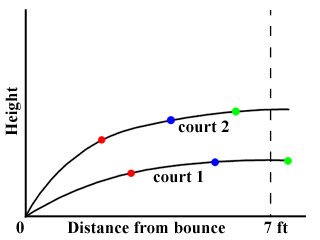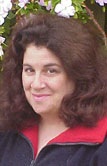January 2007 Article Tennis Server
|

 |
Happy New Year Everyone! With the Australian Open just a few days away, there is tremendous interest in the Number 1 and 2 seeds on the men's side: Roger Federer and Rafael Nadal. Federer dominated the men's game last year with three Grand Slams in 2006 (the US Open, Wimbledon and the Australian Open which he also won in 2004) and runner up to Nadal at Roland Garros. While Nadal had a terrific first half in 2006, the latter part of the last year had some significant disappointments. The speculation is, of course, who will make it to the finals for the 2007 Australian Open. There has been a lot of positive speculation regarding Nadal's performance on the Rebound Ace court in Melbourne. Jim Courier, a two time Australian Open champion himself, noted, "Australia suits Rafa's game the best. The surface really accepts his heavy topspin and accentuates it. The ball will have a lot of extra bite, so the conditions there with the heat and the physicality required to play well down there make this an interesting tournament for him." Bottom line, the Rebound Ace court will provide high bounce and a slower court. Can a court surface at a particular facility make that much of a difference? (Same court surface but at a different facility.) Lleyton Hewitt believed the 2006 Rebound Ace at Melbourne Park contributed to his elimination in the second round of last year's Australian Open. He noted "unacceptably slow, bouncy and inconsistent Rebound Ace". However, it's recently been publicized that this year's court will have a faster pace and lower bounce. Temperature also affects the court surface - some players complaining that the court gets 'sticky' (higher friction). So far, the daily high temperature predictions for Melbourne Park are expected to be between 77-82 °F (with the exception of a high next Wednesday of 87 °F). There may be some showers and thunderstorms next weekend. Tennis courts are made out of a wide variety of materials. Courts are characterized as 'fast' or 'slow' based on the materials and condition of the surface. As the ball hits the court it rolls or skids across the surface. If the ball skids on the court, we say that the court is fast; if it rolls, we say that the court is slow. You know what that means to your game: grass is fast, clay is slow, hard courts someplace in the middle. On clay courts you have a little extra time to reach the ball. If you've played on the grass court you know you have less time to reach the ball -- you need to prepare earlier. You also know that you're lunging and bending a lot more since the ball doesn't rebound as high on grass. Aside from your experience, physics tells us that there is a way to quantify court speed. The two parameters key to this are the coefficient of friction and the coefficient of restitution. Coefficient of Friction (COF) When two objects slide across one another they both exert a frictional force against one another. These forces are always tangent to the surfaces. A tennis ball and its interaction with the court is an example of this. The frictional force is opposite the direction that the ball is traveling. The science of physics gives us the following equation: f = mN for objects that slide against one another; where f, the frictional force is equal to N the normal (upward force that the surface exerts on the ball) multiplied by m, the coefficient of friction. m is not a constant; it will vary with the ball and surface type. The more friction there is between the ball and the court the slower the ball will move after the bounce. Balls that skid on the other hand do not generate as much friction and subsequently do not slow down as much after the bounce. So, the COF tells us how fast (or slow) a ball will reach you in the horizontal direction. The higher the COF is for a court the slower the ball will be after the bounce. Coefficient of Restitution (COR) For ball/court interaction, the COR is a ratio of the vertical velocity after the bounce to the vertical velocity before the bounce. The COR indicates to us how high the ball will bounce. Look at these two trajectories. Let's say that both balls have identical velocities coming off the court. We placed little circles on the graph to mark fractions of a second. Each color on each graph designates the period of time. (Red is 0.1 seconds, Blue is 0.2 seconds, etc.). The x-axis (horizontal) represents distance from the bounce. If you are standing 7 feet from the point that the ball bounced, you can see from the graph that the ball bouncing off court 1 is going reach you sooner than the ball from court 2. Part of what has occurred is the horizontal velocity, the velocity component in the direction that the ball travels, is faster for the ball off of court 1 than for court 2.

Velocity has both a magnitude (speed) and direction component. In trigonometry we learn that the square root of the sum of the squares of sides of a triangle is equal to the hypotenuse. We can apply this same rule to the horizontal and vertical components of velocity: V= (Vx2 + Vy2)1/2; where Vx is the horizontal distance and Vy is the vertical component. So COF deals with Vx and COR deals with Vy. (This is a simplified equation assuming there's no veering off to the side, otherwise you include an additional term Vz.) Today, a compact measuring device is used which is able to calculate ball size (radius), the angle and ball velocity before and after the bounce, contact time with the surface, and how far the ball slides when in contact with the surface. The Wassing sestie has been used by the International Tennis Federation, Lawn Tennis Association (the governing body for the game of tennis in Great Britain) and the French Tennis Federation. The International Tennis Federation's Technical website lists the pace of many specific court surface products. I'm looking forward to seeing how this all pans out next week at the Australian Open.
This column is copyrighted by Jani Macari Pallis, Ph.D., all rights
reserved.
Dr. Jani Macari Pallis is the founder and CEO of Cislunar Aerospace,
Inc., an engineering and research firm in San Francisco. In addition
to her engineering practice, she has led two collaborations between
NASA and Cislunar, creating educational materials on the aerodynamics
of sports for pre-college students and educators. As the head of
NASA's "Aerodynamics in Sports" project, she has led a team of
researchers investigating the aerodynamics, physics and biomechanics
of tennis. The group has conducted high speed video data capture at
the US Open and research of ball/court interaction, footwork, serve
speeds, trajectories and ball aerodynamics. Pallis received a BS and
MS from the Georgia Institute of Technology, an MS in mechanical
engineering from the University of California, Berkeley and a Ph.D.
in mechanical and aeronautical engineering from the University of
California, Davis. She is a member of the Executive Committee of The
International Sports Engineering Association.
Questions and comments about these columns can be directed to Jani by
using this form.
|



October 2022 Tennis Anyone: Patterns in Doubles by John Mills. September 2022 Tennis Anyone: Short Court by John Mills. |
 You will join 13,000 other subscribers in receiving news of updates to the Tennis Server along with monthly tennis tips from tennis pro Tom Veneziano.
You will join 13,000 other subscribers in receiving news of updates to the Tennis Server along with monthly tennis tips from tennis pro Tom Veneziano. 